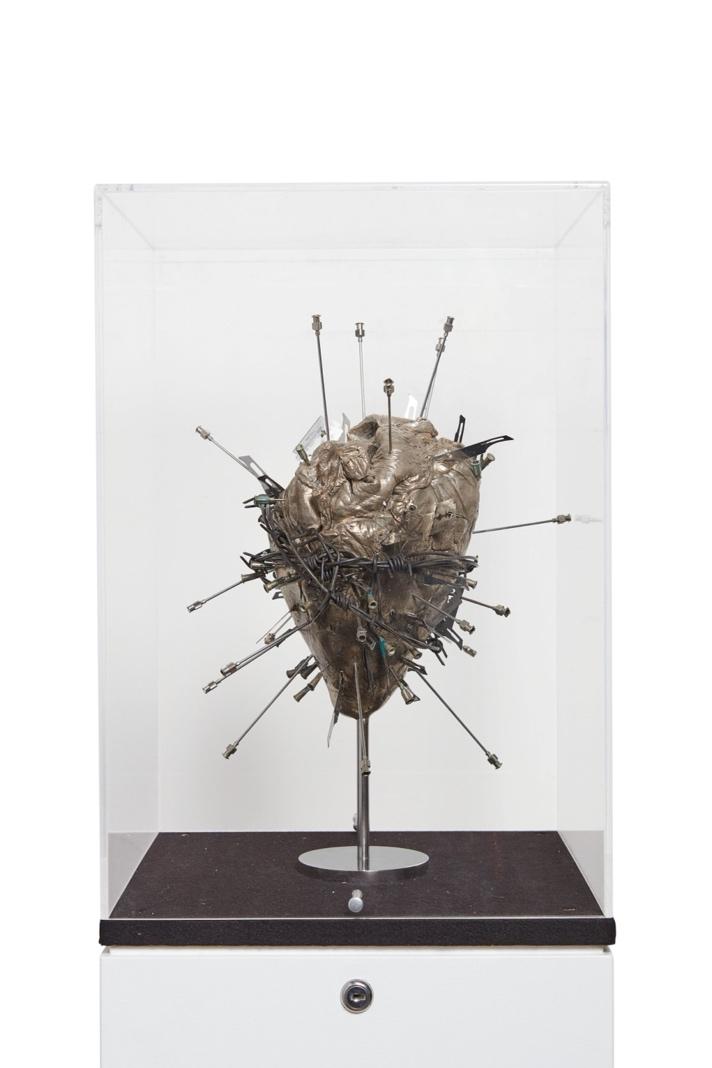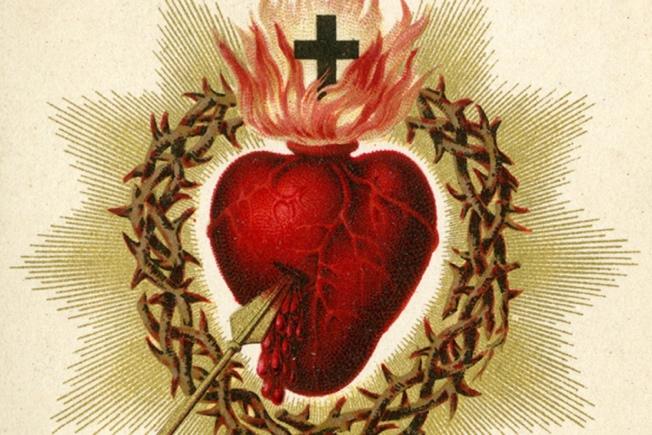The larger theme that can be traced in the majority of Damien Hirst’s artworks is condensing social contradiction into complex and haunting imagery. The artist is known for the continuing tradition of the “commodified sublime” that has its roots in early modernity. Hirst transferred the traditional, historical, and religious symbolism onto gory objects such as animal corpses, skeletons, skulls, preserved body parts, and others. Thus, his preoccupation with death, science, and religion serves as an artistic foundation for attempting to answer fundamental questions about the meaning of life. The art piece “The Sacred Heart” (2005) is one of the pieces of Hirst’s collection of symbolic artworks based on various animal hearts stabbed with assorted sharp objects. The particular object under analysis is a silver sculpture of a human heart (Figure 1), replicating the original bull’s heart suspended in formaldehyde and pierced with surgical instruments. Upon first glance, the sculpture appears unpleasant to look at because an anatomically-correct figure is pierced with varied metal objects; however, after further observation, it calls for a reflection on the changing concept of the sacred and asks to consider how people ascribe meaning to objects and life itself.
The questions prompted by the observations of the “Secret Heart” are some of the many that follow from Damien Hirst’s indictment of religion as viable means of ascribing meaning to human experience. The heart depicted in the sculpture is a clinical reconstruction of a traditional religious image that is known worldwide (see Figure 2 for a comparison with the art piece). By making a direct parallel between his piece and the religious image, the artist intends to comment on religion’s usurpation of the role as a source of hope for people against death, illness, and pain.


The comment on religion’s usurpation of power prompts Hirt’s logic that science presents a new chapter in human development and can replace it for many people. This is a vital component of the Sacred Heart’s reinterpretation, even though the sculpture represents an ambivalent image (Jones). The human heart appears preserved and destroyed simultaneously as a way to comment on the futility of human life and the fact that even science cannot help attain a triumph over death.
The division between the worlds of belief and unbelief is quite binary in the theme inherent to the Sacred Heart. It can only be taken as far under the artist’s own argument that science has also usurped the role formerly played by religion as ‘the path through the darkness (White 20). Furthermore, science has been fundamentally and consistently strong in that it surpassed religion in its capacity to inspire hope among people, thus moving to the forefront as a method of answering moral and existential dilemmas that characterize human conditions. For the artist, the Sacred Heart is a symbol of answers that science can provide to the mysteries of human experience, which are now being solved not through prayer but through empirical means.
Therefore, in the world of both the faithful and the faithless, the questions regarding salvation are the same for all people, even though the sources of the answers differ. Against such an existential backdrop, the imagery that Hirst uses has religious associations. In the “Sacred Heart,” the main object is presented in a cold-hearted manner, challenging the validity of its initial meaning and, thus the validity of religiosity itself. Quoting the artist himself, the value and success of the piece rely on evoking a great degree of impact: “as an artist, you’re looking for universal triggers. […] You want it to have an immediate impact, and you want it to have deep meanings as well. I’m striving for both” (Hirst qtd. in Art Quotes). Even though both science and religion remain the initial sources for answers, works such as “Sacred Heart” force the audience of the artist to consider which source they would like to accept and be able to defend their choices.
The traditional religious image is reconstructed in Hirst’s art piece as a way of illustrating that a cliché could be viewed from a new perspective and be provocative enough to continue exploring questions about the relevance of spirituality in the twenty-first century. The analysis of the theme of the juxtaposition between religion and science is based on the remaking of an image that persisted for centuries. Thus, the inherently religious meaning of a heart being stabbed by a sharp object can have that meaning transformed in order to reveal its emptiness. Hirst’s “Sacred Heart” questions and undermines the Christian visual heritage and asks whether it could be helpful for improving the human condition or not. Viewed as a relic, the silver sculpture of the heart stabbed with needles and razors has both historical and sentimental interest. From a historical perspective, it represents the shift in the worldview of humankind from a religious to a science-driven one. From a sentimental standpoint, the piece illustrates the fragility of human life.
Works Cited
Art Quotes. “Damien Hirst Quotes.” Art Quotes, Web.
“Damien Hirst. Sacred Heart.” Sotheby’s, Web.
Jones, Jonathan. “Damien Hirst: A God I No Longer Believe In.” The Guardian, Web.
“Litany of the Sacred Heart.” Ctsbooks, Web.
White, Luke. “Damien Hirst and the Legacy of the Sublime in Contemporary Art and Culture.” Middlesex University Research Repository, Web.